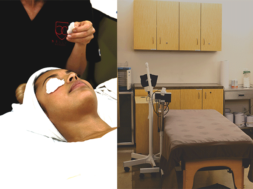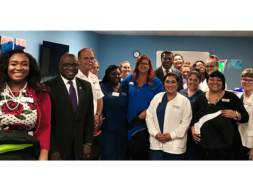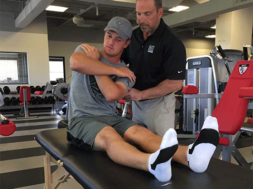
The use of Technology, Social Media, Applications, and Websites to Support Gen Z and Millennial Learners
By Helena M. H. Nadder, RN, MSN, MHA, Ph.D., Visiting Professor, Chamberlain University; Part-Time Faculty, Capella University
There is a new type of learner among us. Millennial learners and Gen Z learners have grown up in the world of the digital age where they are constantly connected and have Google at their fingertips (Kim, 2017). Gen Z and millennial students are more social, desire work-life balance, are used to multitasking, have shorter attention spans, and desire to be participative learners (DeVaney, 2015). Students now expect rapid and robust communication with faculty and more accessibility to faculty including out of classroom communication (OCC). Also, there is a bigger role for technology than ever before (Kim, 2017).
We should recognize that there is a generational gap between students of today and faculty members who may not have grown up in the digital age of technology. Oftentimes, students have different expectations of faculty when they enter college classrooms. Faculty, who may not be comfortable with technology and these expectations, have reported increased stress levels and increased workload as a result (Kim, 2017).
According to Fluck and Dowden (2013), educators are in a unique moment of history where they must straddle “both a pencil and a mouse.”
But the question becomes, how do faculty do this in a way that meets learner needs yet does not increase faculty stress or workload? The answer is the use of particular technologies applied in a strategic way. These technologies must be simple to integrate, utilize, and will meet learner needs.
The purpose of this article is to provide insight into the use of particular technologies which can be applied in both distance education and classroom education which, in turn, will enable faculty to be more comfortable with the use of technology to help meet the needs of the generationally diverse learners of today. The following discussion will include information about the importance of creating welcome videos and other videos for class, using memes and GIFs effectively in class, using Snapchat, Instagram Stories, and the Clips app as teaching tools, and creating blogs and webpages (Facebook, Wix, Formative, and Twitter) to support learning outcomes.
Video
A video is a recording, reproducing, and or broadcasting of moving visual images (Google, n.d.). Many learners are visual and videos can be uploaded and viewed before, during, or after class to engage learners for specific purposes. In a study by Koo et al. (2019), videos were used as a part of a flipped classroom technique and students performed better and were more satisfied. When teaching online, welcome videos are particularly important as this would be one of the only times learners get to see their instructor face to face. Welcome videos can set the tone, serve as an introduction, help faculty offer key deliverables, and provide contact information: make a video from your digital camera, smartphone, or computer with a camera; Upload it to an LMS or send it out as an email attachment to students; upload it to YouTube or an accessible drive like iCloud, Google Drive, One Drive, or Dropbox; project it as part of your presentation on day one of class or send it out early. If you want to get fancy, use a video creation website like Animoto. Animoto technology allows for pictures and videos to be incorporated and accessed via web link (Animoto, n.d.). Orlando (2017) discussed the best video editing systems for education:
- WeVideo (https://www.wevideo.com)
- Pulse app from Microsoft Windows 10.
- Photos app which includes the ability to create and edit videos with music, text, motion, filters, and 3D effects.
- Apple iMovie comes free with any Mac computer
- Camtasia (https://www.techsmith.com/video-editor.html)
- Adobe Spark (https://spark.adobe.com)
Memes and GIFs
According to dictionary.com (n.d.), a meme is a cultural item in the form of an image, video, or phrase that is spread by the internet and altered in a creative and humorous way. GIF stands for graphic interface format (abbreviations.com, 2019) and uses color and animations but does not have audio. Like a meme, a GIF is often spread over the internet. Remember the old adage that a picture is worth a thousand words? Memes and GIFs are perfect examples of this.
Because learning involves new content for many students, it is important to be aware of what Materna (2007) describes as downshifting. When a learner registers a threat, begins to perceive things negatively, or gets overwhelmed, natural learning is hindered.
Memes can break the ice, make students laugh, illustrate course concepts, and help create a comfortable environment.
Per Reyes, Kaeppel, and Bjjorngart-Basayne (2018), we are moving from text to more visual styles of communication. Memes and GIFs offer important social and political commentary that helps to illustrate how we are feeling and or thinking. They can be a coping mechanism and serve as an outlet. They can be used to engage students, help demonstrate concepts, assist in communication. In addition to teacher-created memes which may be projected during the class or online, students can create memes. Reys et al. (2018) illustrated some examples:
- Have students select a meme that shows their personality on the first day of class as a way of an introduction. Have them upload it or place it somewhere accessible like the LMS or a webpage or even a Google doc which the teacher collects and sends through email. On the first day of class, project it on screen and let students talk about why they selected that meme. They will more easily connect with others and a lighthearted classroom environment will be created. Additionally, it could create interest and excitement for meeting each other!
- Have students find a meme or GIF for how they feel about new material. Maybe they feel good, or overwhelmed, or confused, etc. …
- Have students find memes or GIFs that are relevant to a subject and this can create a robust discussion.
Make your own meme or GIF relevant to a course concept. Check out websites like makeameme.org!
Webpages/social media
Webpages like Formative, Wix, Facebook, and Twitter can be instrumental in helping students become more engaged and connect out of class. Additionally, they can be used as tools of classroom instruction as instructors and students are able to communicate via website/apps. Overall, websites are fun and engaging technologies that allow students to access course materials, blog, and interact with their instructor right from their smart device. Students playing on their phone in class? Let them! The following will include a discussion of four relevant websites and social media platforms.
Formative
Formative is a neat website that allows you to create digital questions, embed media content, and upload worksheets for students to read/complete (Formative, n.d.). Formative can be used to support a flipped classroom technique or as pre or post-class assessment. If students can complete assignments prior to class (i.e., Formative) then the class can be used to support deeper and more collaborative learning. Koo et al. (2016) noted that there is a need for students to solve problems and think critically. While passive lectures are common, students are accustomed to technology and desire to collaborate with others. There are multiple resources for how to use Formative including a YouTube video. There is also a chat center and a help center with articles. Setting up a “basic” Formative is free for educators!
Wix
Wix can help you create and design your own professional website (Wix, n.d). For educational purposes, you can create a website that is relevant to the course that you teach. For example, you could have information on this website for students to access and/or respond to. Or you could create a blog and students could log on and respond. Their responses can be viewed in an app in real-time, or student responses can go directly to the instructor’s email. There are Wix website designers on staff that you can hire and a large help center with support phone numbers. Generally, it is user-friendly. You can change privacy settings so that only visitors with a password can access your Wix page.
Who’s not on Facebook these days? Why don’t you take advantage of that? You can create a Facebook page or a group. Come on, you know they check Facebook a few times a day at least. With Facebook, it is important to consider the difference in a page or group so you can create the right fit for your class.
Facebook Page
Pages are similar to a “friend profile” which most of us have. “Like a friend’s profile, Facebook Pages create an authentic public presence, but unlike your profile, Facebook Pages are visible to everyone on the internet by default. Everyone on Facebook can connect, be a fan, and receive updates” (Hicks, 2010, para 4). Change privacy and other settings by clicking on the settings tab.
Facebook Group
This is the best place for small communication. “Through a Facebook group, students can come together around a common cause or activity to organize, express objectives, discuss issues, post photos, and share related content” (Hicks, 2010, para 8). You can navigate and set up your group by using administrator/moderator tools. For groups, you can select the type of group (see below), invite members, moderate the group (approve members) and create rules for the group. When you create a group, you decide who can join. Additionally, the group “type” can be public, closed, or secret. With a public group, anyone can see the group and post. For a closed group, anyone can find it and see who runs it, but only members can post, but you can search it out and request to join. For a secret group, only members can see the group and someone must invite you to join. When you want to disband it, simply delete the group.
Twitter is an online news and social site where people communicate with small messages called tweets. Tweets can be up to 280 words (Twitter, 2019)! A great way to connect with students and provide updates/info. You can post pictures, video, GIFs, etc.
Other apps
Applications (apps) can be downloaded to your smartphone. You can click on the app and see content that has been communicated. The three discussed below are Snap, Instagram Stories (IS), and the Clips app, although there are many more.
Snap
With Snapchat, you can communicate, post photos and post videos that are shared and cannot be viewed if 24 hours have elapsed. With Snapchat you can create groups of people to which you can send pictures or videos with information. You can create a group of up to 31 people to send snaps to! Once you have the app, you can have people follow you. You can use Snapchat to provide student guides and links. For example, provide a link to a Google doc, scoring rubric, or a relevant article in the library! In Venables’ article “Adventures with Snapchat” (2019), Venable noted the following uses of Snapchat for an activity planning matrix:
- Plan out your week with snaps – Monday announcements, Thursday assignment reminders, Friday career tips.
- Use snaps for assignment clarification.
- Use snaps for questions – Students can snap a question that can get a quick response.
- Use snaps to making connections. For example, you could foster communication when you snap about hobbies and travel. Get to know students – form relationships.
- With Bitmoji integration, you can use an emoji that looks like you which can create more interest and be more engaging.
Snapchat “… improves instructor presence… engages and connects students outside of the course to build community and encourage the development of friendships that might extend past graduation” (Venable, 2019., para 1).
Instagram Stories (IS)
Instagram works in a similar way to Snapchat in that it is a picture or video which deletes in 24 hours. Students are using IS to communicate and some students prefer this to Facebook. “To view someone’s story tap on their profile photo and their story will appear full-screen showing you all of the content, they’ve posted in the last 24hrs. The content will play in chronological order from oldest to newest” (Instagram Story, n.d., para 5).
Clips
Clips is a type of app where you can create pictures and videos (Clips app, 2019). Ingalis (2019) wrote about using Clips app as an exit ticket for a class: Ingalis had students create a Clips app video about relevant class content as an exit ticket to her class. She noted that video creation became a multi-voiced classroom narrative tool for metacognition. Using the Clips app can help teachers to figure out what students know/don’t know and adjust teaching accordingly. Using the Clips app lent itself to group collaboration and team cooperation, and teachers enjoyed quick, easy grading (Ingalis, 2019).
Compliance and best practices
It is important to let your supervisor know what technologies you are using. Review organizational policies and alert your IT team for additional guidance. Management and IT can oftentimes offer feedback and assistance. Remember, when using memes or GIFs, cite them correctly and be aware of copyright. As far as social media, reinforce with your class that this is a “safe space” where postings should be about class topics only and post in a way that should be encouraging, unifying, and not offensive. Have the class set up rules collaboratively so that everyone has buy in and understands what to post and what not to post. As the administrator, you should monitor any postings and delete if necessary.
Conclusion
The classroom of the future will be focused on building community, socialization, and collaboration. This could be done through web 2.0 technologies and social media like Facebook and Twitter. Tools like memes and GIFs can help students show their personality and provide important social commentary. Videos and Formatives will allow learning to occur outside the classroom, and Snapchat will help instructors create a fun and communicative presence that students desire. Teaching strategies must support active learning and new learning models should be utilized. Educators must rethink the traditional paradigm of education and engage in student-centered teaching which will interest, challenge, and stimulate learners (Bristol & Zerwekh, 2011). Faculty must embrace and use technology and innovative methods of education. Generation Z and millennials desire a learning environment that is flexible, accessible, and able to be easily incorporated into their lifestyle. Teaching must help students grow, develop, and be successful (Cannon & Boswell, 2016). So, since students desire out of class communication (OCC), let’s offer this by engaging in the strategic use of technologies (such as the ones I have mentioned) which will make students feel connected without overwhelming them (or us)!
References
- Abbrevaition.com. (n.d) GIF. Retrieved from https://www.abbreviations.com/GIF
- Animoto (n.d) Retrieved from www.animoto.com
- Bristol, T. J., & Zerwekh, J. (2011). Essentials of e-learning for nurse educators. Philadelphia, PA: F. A. Davis Company. ISBN: 9780803621732.
- Cannon, S., & Boswell, C. (2016). Evidence-based teaching in nursing: A foundation for educators (2nd ed.). Burlington, MA: Jones & Bartlett Learning. ISBN: 9781284074734
- Clips app. (2019) Spread some joy. Retrieved from https://www.apple.com/clips/
- DeVaney, S. A. (2015). Understanding the millennial generation. Journal of Financial Service Professionals, 69(6).
- Dictionary.com (n.d). Meme Retrieved from https://www.dictionary.com/browse/meme
- Formative (n.d) Retrieved from https://goinformative.com
- Fluck, A., & Dowden, T. (2013). On the cusp of change: examining pre-service teachers’ beliefs about ICT and envisioning the digital classroom of the future. Journal of Computer Assisted Learning, 29(1), 43-52. doi:10.1111/j.1365-2729.2011.00464.x
- Google. (n.d). Video. Retrieved from https://www.google.com/search?q=what+is+a+video&rlz=1C1EJFA_enUS800US800&oq=what+is+a+vide&aqs=chrome.0.0j69i57j0l4.7830j0j8&sourceid=chrome&ie=UTF-8
- Hicks, M. (2010) Facebook tips: What’s the difference between a Facebook page and group? Retrieved from https://www.facebook.com/notes/facebook/facebook-tips-whats-the-difference-between-a-facebook-page-and-group/324706977130/
- Ingalis, V. (2019). A video based exit strategy sparks engagement. The Teaching Professor. Retrieved from https://www.facultyfocus.com/articles/teaching-with-technology-articles/a-video-based-exit-ticket-sparks-engagement/
- Instagram Stories (n.d) The complete guide to using stories. Retrieved from https://buffer.com/library/instagram-stories
- Kim, C. (2017). Millennial learners: Perceptions and expectations of out-of-class communication. Teaching Journalism & Mass Communication, 7(2), 23-31. Retrieved from http://library.capella.edu/login?qurl=https%3A%2F%2Fsearch.proquest.com%2Fdocview%2F2150381281%3F
- Koo, C. L., Demps, E. L., Farris, C., Bowman, J. D., Panahi, L., & Boyle, P. (2016). Impact of flipped classroom design on student performance and perceptions in a pharmacotherapy course. American Journal of Pharmaceutical Education, 80(2), 33.
- Materna, L. (2007). Jump start the adult learner: How to engage and motivate adults using brain-compatible strategies. Thousand Oaks, CA; Corwin Press. ISBN: 9781412952941.
- Makeameme (n.d) Retrieved from https://makeameme.org/meme/what-the-heck-5c9e34
- Orlando, J. (2017). The best video-editing systems for education. The Teaching Professor. Retrieved from https://www.teachingprofessor.com/topics/teaching-strategies/teaching-with-technology/best-video-editing-systems-for-education/
- Reyes, Kaepell, Bjornard-Basayne (2018). Memes and GIFs as powerful classroom tools. Faculty Focus Retrieved from https://www.facultyfocus.com
- Twitter (2019). Help Center. Retrieved from: https://about.twitter.com/en_us/lets-go-twitter.html
- Venable (2019). Adventures with Snapchat. The Teaching Professor. Retrieved from https://www.teachingprofessor.com/topics/online-learning/teaching-strategies-techniques/adventures-with-snapchat-in-an-online-course/
- Wix (n.d.) Retrieved from https://www.wix.com/
DR. HELENA NADDER, Ph.D., MSN, MHA, RN,is a native of Charleston, WV. A nurse for over 20 years and educator for over 10 years, Dr. Nadder obtained a bachelor’s degree in nursing (BSN) from West Virginia University in Morgantown, WV, in 1999, a Master of Science in Health Care Administration (MHA) from Marshall University in Huntington, WV in 2002, a Master of Science in Nursing (MSN) in 2017 and a Ph.D. in Nursing Education in 2018. Dr. Nadder has served in various clinical and management nursing roles including RN (River Park Hospital), Charge RN (River Park Hospital), Nurse Manager (Mildred-Mitchell Bateman Hospital and Kings Daughters Medical Center), Director of Nursing (Akron General Medical Center) and Chief Nursing Officer (Ohio Hospital of Psychiatry).
In 2010, Dr. Nadder made the switch from clinical practice and management to full-time nursing education and began teaching in various capacities for Chamberlain University. Over her 15-year career in nursing education, Dr. Nadder has taught both on-campus and online, to include students seeking associate degrees, baccalaureate degrees, and master’s degrees in nursing. Dr. Nadder is currently teaching informatics courses online at Chamberlain University as a Visiting Professor and is Part-Time Faculty for Capella University where she teaches health information technology and evidence-based practice courses.
Professionally, Dr. Nadder enjoys educational research and publishing. She also enjoys presenting and has presented on the local, state, and national circuits. Her hobbies include reading, writing, playing the piano, tennis, and jogging. She is active in her church and community.
Contact Information: Helena M. H. Nadder // Visiting Professor, Chamberlain University; Part-Time Faculty, Capella University // Chamberlain University and Capella University // 304-546-0436 (cell) // helenahabib@yahoo.com











